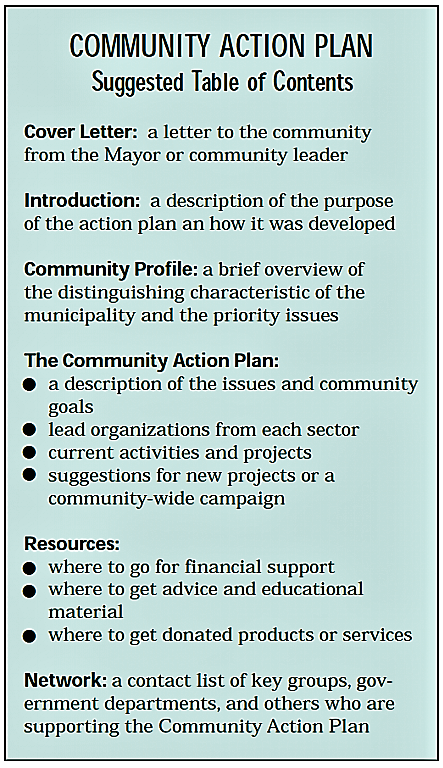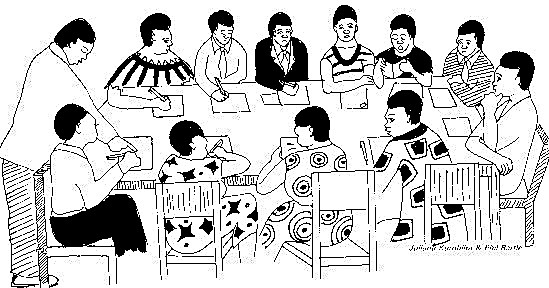Community Action Play It Again Clothing
04 September 2019
Community Action Plan
Executive Summary
A community activeness plan is a road map for implementing customs change by identifying and specifying WHAT will be washed, Who will do it and HOW it will be washed. In other words, the activity plan describes what the community wants to accomplish, what activities are required during a specified timeline and what resources (coin, people and materials) are needed to be successful. The community action plan shall become a framework for implementing sustainable sanitation and water management activities that are decided past the customs itself. It is of import to emphasise that the community members should be the main actors in preparing their own customs activity program regarding sanitation and water management.
Advantages
Strong participation of the local customs regarding sanitation and water issues
By implementing community activeness plans, the solution for problems comes from the community itself and hence considers primarily their needs and priorities
Guarantees that all relevant groups participate in the activities, particularly the women and other community groups that are often forgotten
Guarantees the acceptance and support of the solution by the local community
Disadvantages
Requires time and resource to integrate all the relevant stakeholders in the process
Finding consensus amidst all the community members tin can take ages or might exist incommunicable
Community activeness plans are non going to be developed without strongly motivated and encouraged local community members
What Is a Community Action Plan?
Factsheet Block Torso
(Adjusted from ACPHD 2004; FAO 2001; UNDP n.y.)
"A healthy community is a form of living democracy: people working together to address what matters to them".
The community activeness plan is 1 of the participatory tools used to build the capacity of community members in taking action in accordance with the bug, needs, and potential of the community (see also problem assay and determination making, both categories on Decision Making department).
The community activeness programme is a route map for implementing community modify in sanitation and water management by clarifying what will be washed, who will practise it and how it will exist done. The plan describes what the community wants to achieve, what activities are required during a specified fourth dimension catamenia, what resources (money, people and materials) are needed to be successful.
The community action program should get a framework for implementing the activities that are decided past the community itself. The focus is more than on the procedure of understanding and overcoming problems in guild to rebuild the people'south lives rather than simply concrete evolution such as building houses, providing clean water or toilet facilities. It is important to understand that the community should be the master actors in preparing their own community action plan. Producing the activity plan helps people to have realistic and physical steps toward participatory evolution planning in club to improve the sanitation and h2o system. By bringing anybody together to recollect and discuss about resource and group involvement, this tool increases sensation (encounter PPT) almost the skills and resources already available in the customs.
Central Elements of a Community Activeness Plan for Sanitation and Water Management
Factsheet Cake Body
(Adapted from MIT northward.y.)
The key chemical element of community activity planning is an agile, intense community-based workshop, carried out over a time menstruum of 2 to five days, depending on the specific objectives of the workshop (see besides exploring tools). The output of the workshop is a sanitation and water direction development programme which contains a list of prioritised problems, strategies and options for dealing with the identified problems. A rudimentary piece of work programme describes who, when and what is to be done. Integral to the method is the equal relation between the professional person technical inputs and planned over specified intervals – once each year tends to be appropriate – with the implementation of agreements during the interval.
The execution of the workshop requires a minimum of preparation, materials and training. Of prime importance is a motivated community and a confident moderator/facilitator/organiser who can take the lead in assuring that announcements are fabricated, participants identified, a location selected, a few materials nerveless, and finally in running the workshop. However, most of the grooming should exist done past the community itself. A designated person oft takes responsibleness for the logistics. Moderators need non be highly skilled and tin can adjust the style and content to suit their own temperament and the prevailing circumstances. Preparation of moderators/facilitators can be minimal, but is strongly advised to participate in an actual workshop in order that futurity moderators tin capture the dynamics of the event as much every bit empathize its procedures (run across also train the trainers perspective).
Materials required are limited to markers of some kind, large sheets of paper (any kind: wrapping newspaper, newsprint, cardboard, unfolded boxes), and a place for display of outputs.
The location for the workshop should be in the community and hands attainable, rather than in government offices. Case locations have included formal classrooms.
Full general Principles of Community Action Plans
Factsheet Cake Body
(Adapted from UNDP due north.y.)
- Information technology is a procedure for action; not a blueprint for hereafter evolution.
- The solution for problems comes from the community itself and the function of the facilitator is more than on formulating the problems in the community.
- It is not adamant from exterior the community but grows/emerges from the affected customs.
- Avert activities such equally lecturing or teaching the people; simply concentrate more on workshops every bit a form of word with the community.
- Guarantee that all relevant groups participate in the activities, particularly the women and other customs groups that are often forgotten.
- Facilitate input from all groups; practise not allow ane grouping or leader to dominate the discussion.
- Remember that one upshot might announced to be not very of import for i group, just is important for another grouping.
- Avoid also many pictures and text; it is better to absorb and call up several points rather than make a long listing.
- Utilise unproblematic language and avoid difficult terms.
- Make the fabric as simple every bit possible.
Steps in Formulating a Community Activeness Plan
Factsheet Block Body

(Adjusted from UNDP n.y.)
The development and formulation of a community activeness plan consists of several standard measures that are generally applicable. Yet, in practice, the specific context and nature of customs needs in sustainable sanitation and water management will add uniqueness to those measures.
The stages in formulating a community action plan tin can exist described every bit the following:
-
Opening: Introduction and Socialisation: This first phase intends to provide a common understanding of the importance of having a expert action program, and a common agreement of why an action plan is needed.
-
Social and Ecology Mapping financing: This stage is meant to proceeds an agreement of the latest conditions in the community life that is the social, economical, as well every bit environmental conditions. Past developing a map, the community will be able to get a better picture of problems and priorities (see as well sympathize your system).
-
Identifying the Bug, Needs, and Resource Potential: This stage defines the problems that are really faced by the community, the needs that must be fulfilled in order to overcome the (sanitation and water management) problems, and the financial resources (see PPT) available to accomplish the needs. This process of identification should be washed carefully in order to avoid becoming just a task of making a "wish list", and should be viewed as a process of understanding the current situation and what must be done to overcome the situation as fast every bit possible.
-
Determining the Priority in Issues and Needs: In this phase the problems and needs are ranked by the community members according to their level of urgency (see preference ranking), their importance for the development of customs life, and the opportunity to overcome and to fulfil (viewed in terms of the availability of local resource too as external resources that might be reached).
-
Formulating the Choice of Strategy: In this stage, the strategy is developed and the approach chosen that is the most feasible to be used in overcoming the issues and fulfilling the needs on the priority list (see also deciding).
-
Formulating the Pick of Activity: In this stage, it is adamant which action has to exist taken in implementing the chosen strategy and approach.
-
Formulating the Implementation Plan: This phase is used to codify a schedule and the division of tasks in carrying out the action chosen (see also stakeholder strategy plan).
-
Formulating the Monitoring and Evaluation Plan: This stage is used to codify a program and system of monitoring and evaluating the execution of activities.
-
Implementation, Monitoring and Evaluation: This concluding stage consists of carrying out the action, and at the same fourth dimension monitoring and evaluating. For more information on these individual steps, see as well implementation).
Considerations for Completing a Community Action Plan
Factsheet Block Body

(Adjusted from ACPHD 2004)
The following points should be taken into consideration in completing a community action plan:
-
Partnerships amongst people. In order to accomplish the goals and objectives in the plan how to amend the sanitation and water system of your expanse, many people will have to exist integrated and have to fully participate in doing the work. It is important that the involved people develop good relations and trust amid each other (encounter also stakeholder assay starting by stakeholder identification factsheet).
-
Budget. Fiscal resources are unremarkably necessary to develop and comport out a community action plan for sanitation and h2o management. Therefore, it is important to develop a budget that describes the expenses for carrying out the activity plan. What you include in the upkeep should friction match the proposed strategies and activities (see financing and sources of funding).
-
Close alignment with the community'south mission and vision. The vision that was developed during the community assessment process reflects where the customs wants to be headed. The mission is the purpose of your group. During the writing of the action plan, the writers piece of work from the vision and the mission to place several major goals (priority or strategic) that must exist reached. These, in total, piece of work toward the vision and the mission.
-
A feasible program does not have to be "perfect".More important than a "perfect" action program for sanitation and water management is one that is feasible for the customs partnership to complete within a reasonable menstruation of fourth dimension. The action programme is a working document that can exist reviewed as the group implements information technology. Information technology is a starting point that people can continue to update and revise as community groups learn over fourth dimension and through their evaluation, how to accomplish their goals.
Applicability
When local customs members are bang-up to change and meliorate their sanitation and water organization respectively management, they starting time need a community action plan which describes what the community wants to attain, what activities are required and what resources are needed to be successful.
A community activity program is required and should exist applied whenever community members want to be the engine of the change regarding sanitation and water bug. It is of prime number importance to strongly integrate local people in the planning of their water and sanitation system in lodge to reach a sustainable solution which is highly accepted and supported by the local customs.
mcginleynownspattles.blogspot.com
Source: https://sswm.info/sswm-solutions-bop-markets/improving-water-and-sanitation-services-provided-public-institutions-1/community-action-plan
0 Response to "Community Action Play It Again Clothing"
Post a Comment